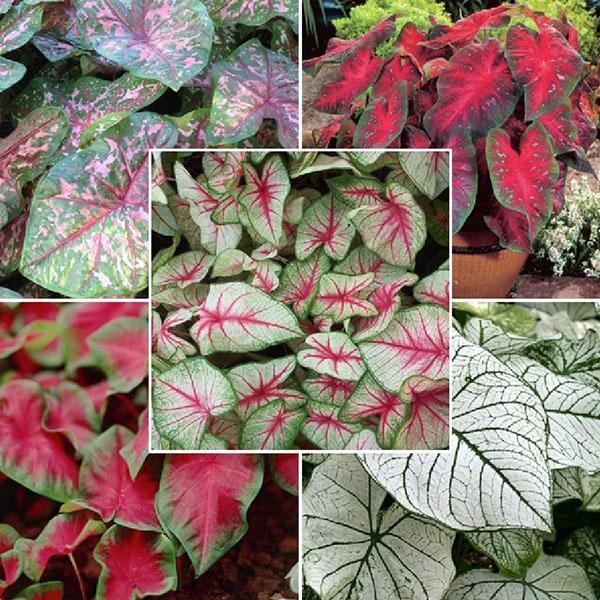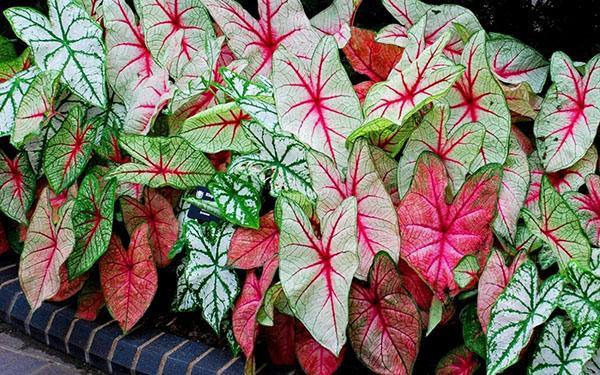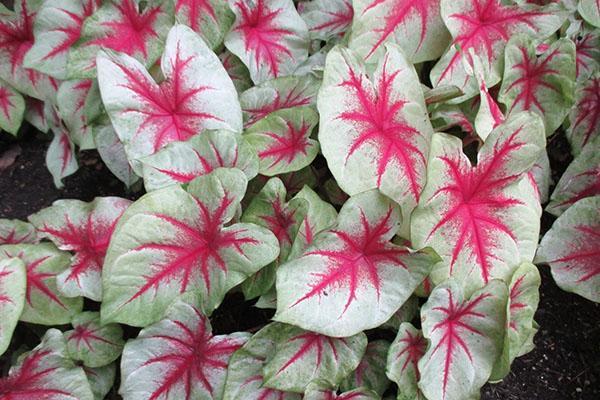Features of caring for caladium and a description of its varieties
 Caladium should replenish the collection of houseplants of the hostess. Its spectacular heart-shaped or arrow-shaped leaves, growing from the roots, look gorgeous even in the most modest interior. The luxurious color of this representative of the Aroid family brings notes of pomp to any room or greenhouse. This masterpiece of nature will be admired by those who are far from gardening. Read about: perennial primrose, its planting and care in the open field.
Caladium should replenish the collection of houseplants of the hostess. Its spectacular heart-shaped or arrow-shaped leaves, growing from the roots, look gorgeous even in the most modest interior. The luxurious color of this representative of the Aroid family brings notes of pomp to any room or greenhouse. This masterpiece of nature will be admired by those who are far from gardening. Read about: perennial primrose, its planting and care in the open field.

You can safely decorate a flower bed or lawn with this tropical bush. In the shade of a tree with a not very thick crown, it will look representative.
General characteristics
The first thing that catches the eye of housewives is the appearance of the flowerpot. They carefully examine its leaves and inflorescences.
Leaf shape
 Depending on the variety, this perennial has a different leaf shape. The most famous are:
Depending on the variety, this perennial has a different leaf shape. The most famous are:
- In the shape of a heart. Familiar to many under their second name - "Christ's Heart".
- As thin as possible, almost triangular.
- Like an arrowhead or a spear.
- Large and wide, like the ears of an elephant.
They do not have a pronounced stem. The leaves grow directly from the rhizome. In the natural environment, they reach 5 meters, and decorative specimens - only up to 30 cm.
War paint
 Appreciate this variety of Aroids for an amazing combination of bright colors. Although there is very little green, it is still dominant. In this case, the leaves are both dark marsh and greenish-white tones. They often depict "compositions" of:
Appreciate this variety of Aroids for an amazing combination of bright colors. Although there is very little green, it is still dominant. In this case, the leaves are both dark marsh and greenish-white tones. They often depict "compositions" of:
- patterns;
- vein;
- mosaic ornaments;
- grid pattern;
- abstract spots;
- gradation of shades (smooth transition from one to another).
 A distinctive feature of some species is a contrasting multicolored border. In rare cases, the leaf edge may be slightly wavy. Among other things, Caladium seduces with its extraordinary combination of bright colors, such as:
A distinctive feature of some species is a contrasting multicolored border. In rare cases, the leaf edge may be slightly wavy. Among other things, Caladium seduces with its extraordinary combination of bright colors, such as:
- lilac;
- pink;
- silver;
- crimson;
- yellow.
This is not a complete list of color variations. The only thing is that the leaves never come with a bluish tint.
The plant is poisonous. Contact with the juice on the skin can cause an allergic reaction (rash, redness). Therefore, the flowerpot should be kept away from babies.
Inflorescences
 They can be described in two words: miniature and nondescript. The bloom resembles an ash-colored ball wrapped in a pale palanquin. It seems as if he is in a cocoon. For exotic lovers, inflorescences will be associated with the wild tropics.
They can be described in two words: miniature and nondescript. The bloom resembles an ash-colored ball wrapped in a pale palanquin. It seems as if he is in a cocoon. For exotic lovers, inflorescences will be associated with the wild tropics.
Variety collection
 At home, there are up to 15 popular varieties of the caladium flower. Each of them differs in appearance, tubers, and conditions of detention. Here are some of the famous varieties.
At home, there are up to 15 popular varieties of the caladium flower. Each of them differs in appearance, tubers, and conditions of detention. Here are some of the famous varieties.
The soil should have a loose and coarse fiber structure, but sufficient nutritious. The acidity of the soil is neutral.
Schomburg
 The shape of the leaves weakly resembles a heart. The plate is 15 cm long and 12 cm wide. Their base is oval or elliptical.
The shape of the leaves weakly resembles a heart. The plate is 15 cm long and 12 cm wide. Their base is oval or elliptical.
The lower part of the leaf plate is painted in light colors: white or pink. There is a greenish border around the edges.Ornate patterns of a silvery shade shine through between the pink veins. Alternatively, the veins may be cream colored. The edge of the plant is bright green in color. See also photo of room tradescantia!
Bicolor
 It is popularly known as two-color arum. The incomparable combination of two contrasting shades of red and green makes the triangular-shaped leaves the highlight of the greenhouse. However, there are varieties with white pigmentation.
It is popularly known as two-color arum. The incomparable combination of two contrasting shades of red and green makes the triangular-shaped leaves the highlight of the greenhouse. However, there are varieties with white pigmentation.
Pink spots on a dark background look sophisticated and romantic. For the bedroom, this will be an exceptional decor option.
Large leaves look elegant on thin stems. They are 10-19 cm wide and over 30 cm long. This decorative caladium flower will perfectly fit into an empty corner of the living room.
Humboldt
 As the name implies, a complementary color to dark green is a metallic shade of silver. Shapeless spots of various sizes serve as a pattern. The central and lateral veins are always green.
As the name implies, a complementary color to dark green is a metallic shade of silver. Shapeless spots of various sizes serve as a pattern. The central and lateral veins are always green.
At the peak of growth, the length of leaves of this type is 8 cm, and the width is 5 cm. They are ovoid with a built-up edge. Since the foliage is small, one pot can fit from 10 to 25 units.
 These are the most famous and widespread varieties. In addition, rare, but at the same time more luxurious species were bred. Among them there is a Caladium, some photos are shown below:
These are the most famous and widespread varieties. In addition, rare, but at the same time more luxurious species were bred. Among them there is a Caladium, some photos are shown below:
- Florida Sweetheart, Sunrise and Red Ruffles.
- Carolyn Worton.
- "Pink Beauty".
- Fanny Manson.
- "Candy land".
- Scarlet Pimpernel.
- Rosalia.
 The Florida variety is distinguished by the oblong shape of the leaves. Scarlet streaks are a characteristic feature of the group. A unique species of the Aroid family is Rosalia. The glossy brown-red surface with dark edging makes this flower an elegant look.
The Florida variety is distinguished by the oblong shape of the leaves. Scarlet streaks are a characteristic feature of the group. A unique species of the Aroid family is Rosalia. The glossy brown-red surface with dark edging makes this flower an elegant look.
 As noted, these exotic varieties are very finicky. Thus, it is important to learn some of the planting and caring aspects of the Caladium.
As noted, these exotic varieties are very finicky. Thus, it is important to learn some of the planting and caring aspects of the Caladium.
Care secrets: from planting to hibernation
 Home care of this type must be carefully thought out and planned. It is always necessary to carefully monitor:
Home care of this type must be carefully thought out and planned. It is always necessary to carefully monitor:
- soil condition;
- temperature;
- lighting;
- humidity.
 Taking care of him, it must be borne in mind that the Amazon rainforest is the homeland of this plant. This understanding will help create decent conditions for him.
Taking care of him, it must be borne in mind that the Amazon rainforest is the homeland of this plant. This understanding will help create decent conditions for him.
Content secrets
 The main thing to do when caring for caladium at home (photos of all the subtleties are given below) it is to protect it from cold and direct sunlight.
The main thing to do when caring for caladium at home (photos of all the subtleties are given below) it is to protect it from cold and direct sunlight.
The pot should be placed on the windows in the western or eastern part of the house. After all, this variety prefers a shady habitat.
 In order for a houseplant to grow violently, it is important to constantly maintain the following parameters in normal condition:
In order for a houseplant to grow violently, it is important to constantly maintain the following parameters in normal condition:
- Temperature. In summer, the thermometer should not fall below 21-25 ° С, and in winter - 16 ° С.
- Humidity. You need to keep it as high as possible.
- The soil. The land must contain the following elements: peat, perennial humus, deciduous waste, sand.
- Spraying with a spray bottle... This procedure must be carried out so that the dew settles smoothly on the leaves. Therefore, you need to spray around or over it, then there will be no brown pigmentation on the leaves.
- Watering. To do this, you need to use settled water and, preferably, it should be soft.
- Fertilizer... Caladium needs mineral dressing twice a month in spring and summer. During hibernation, it should be stopped.
 The dormant season begins in August, so you shouldn't worry if the leaves start to fall. New shoots will appear in March. But in order for them to start growing, you need to periodically (1-2 times a month) moisturize the tubers so that they do not shrivel. As a result, they will be ready for transplant by spring.
The dormant season begins in August, so you shouldn't worry if the leaves start to fall. New shoots will appear in March. But in order for them to start growing, you need to periodically (1-2 times a month) moisturize the tubers so that they do not shrivel. As a result, they will be ready for transplant by spring.
An ideal way to maintain soil moisture is a pallet. You can pour gravel, moss or expanded clay into it.
Reproduction
 It can be done in two ways: with tubers and seeds.Of course, in the latter case, this process will take longer. To do this, you need to take a container with a peat-sandy substrate and sow seeds. The resulting mini-plantation must be covered with a glass lid. If you water it 2-3 times a week and ventilate it, sprouts will sprout in a month. By September, the tubers themselves are formed.
It can be done in two ways: with tubers and seeds.Of course, in the latter case, this process will take longer. To do this, you need to take a container with a peat-sandy substrate and sow seeds. The resulting mini-plantation must be covered with a glass lid. If you water it 2-3 times a week and ventilate it, sprouts will sprout in a month. By September, the tubers themselves are formed.
With an annual transplant, prophylaxis against late blight should be done. For this, you can use a new generation of fungicides.
The most efficient breeding method is tubers. They should be transplanted in late winter or early spring. In this case, it is necessary to observe all the subtleties of the procedure:
- Separate the tubers carefully. Large specimens should be cut in half or in 4 pieces, depending on the number of buds.
- Charcoal can be used as a powder for the cuts.
- The soil should contain sand and peat.
- They need to be transplanted into a larger pot than before.
- Placing seedlings is important in a warm and well-lit place.
- Watering should be carried out as the soil dries.
In winter, the flower may start to rot. The damaged areas must be cut off by treating the surface with some kind of powder-type fungicide.
 All this will make the exotic plant feel at home. However, it is important to remember that its main enemy is aphids. Having found this pest, it is important to thoroughly wash the leaves under running water. When they dry, they should be treated with insecticides.
All this will make the exotic plant feel at home. However, it is important to remember that its main enemy is aphids. Having found this pest, it is important to thoroughly wash the leaves under running water. When they dry, they should be treated with insecticides.
With such care, this flower will delight its owners for many years. It will create coziness in the room, as well as a great view in the living room.